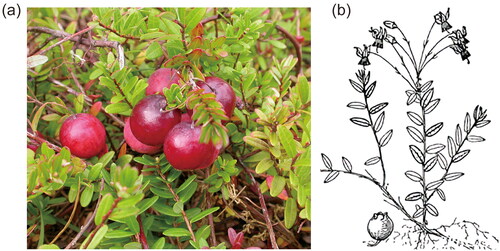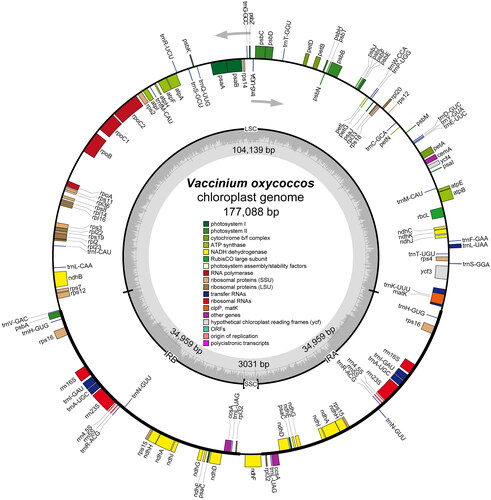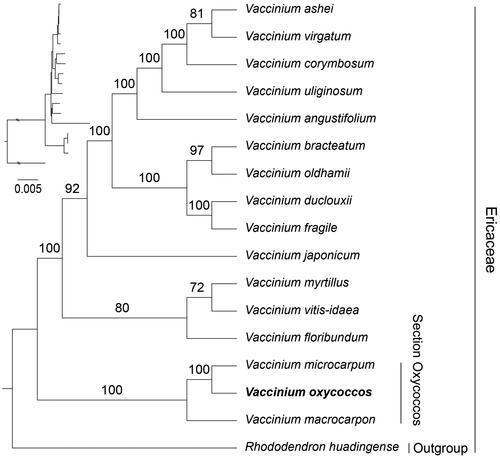Figures & data
Figure 1. Species reference map of V. oxycoccos. (a) Fruits and leaves of V. oxycoccos (voucher number: VO001; this picture was taken by Xinrong Qiao from the Xinyang Agriculture and Forestry University, Xinyang city, Henan Province, China; 128.094687°E, 42.053095°N;). (b) Sketch of V. oxycoccos (from the Plant photo bank of China). core features: V. oxycoccos is an evergreen subshrub of the genus Vaccinium in the family Ericaceae. Its young branches are slightly hairy, and the stem bark is striped; the leaves are oblong or ovate, dark green above, grayish-white below, and glabrous on both surfaces; the flowers are subumbellate; the pedicels are fine, pilose, and recurved at the tip; the corolla is light red, divided nearly to the base, and the lobes are oblong; the berries are red; the flowering period is June to July; the fruiting period is July to August, and the fruit is edible. Its chromosome number is 2n = 48, and it is a widespread species in the Sub-boreal and boreal zones of the Northern Hemisphere, born in cold swamps, and generally reproduced by seed. In China, it is mainly found in the Changbai Mountain of Jilin Province.

Figure 2. The chloroplast genome map of V. oxycoccos. Genes on the inside of the circle are transcribed in a clockwise direction and genes on the outside of the circle are transcribed in a counter-clockwise direction.

Table 1. Summary of the chloroplast genomes of V. oxycoccos and V. microcarpum species.
Figure 3. Phylogenetic tree based on the concatenated sequences of 74 protein-coding genes in 16 species by maximum-likelihood (ML). values split by backslashes above branches represent ML bootstraps. The best-fit model was TVM + F+R4. Branch supports were tested using ultrafast bootstrap (UFBoot) with 1000 replicates. The scale is 0.005 in the tree. Vaccinium oxycoccos (OQ865185) was marked in bold. The following sequences were used: Vaccinium ashei OP113950, Vaccinium virgatum OM791343 (Fahrenkrog et al. Citation2022), Vaccinium corymbosum OM791342 (Fahrenkrog et al. Citation2022), Vaccinium uliginosum LC521968 (Kim et al. Citation2020), Vaccinium angustifolium OM791344 (Fahrenkrog et al. Citation2022), Vaccinium bracteatum LC521967 (Kim et al. Citation2020), Vaccinium oldhamii MK049537 (Kim et al. Citation2019), Vaccinium duclouxii MK816300 (Chen et al. Citation2019), Vaccinium fragile MK816301 (Guo et al. Citation2019), Vaccinium japonicum MW006668 (Cho et al. Citation2021), Vaccinium myrtillus OM809159 (Fahrenkrog et al. Citation2022), Vaccinium vitis-idaea LC521969 (Kim et al. Citation2020), Vaccinium floribundum OQ331035, Vaccinium microcarpum OQ865186 (Fahrenkrog et al. Citation2022), Vaccinium macrocarpon JQ757046 (Fajardo et al. Citation2013), rhododendron huadingense OM177184 (An et al. Citation2022).

Supplemental Material
Download MS Excel (14 KB)Supplemental Material
Download MS Excel (19.2 KB)Supplemental Material
Download MS Excel (12.9 KB)Supplemental Material
Download JPEG Image (1.4 MB)Supplemental Material
Download JPEG Image (2.7 MB)Supplemental Material
Download JPEG Image (318 KB)Supplemental Material
Download JPEG Image (247.1 KB)Data availability statement
The genome sequence data that support the findings of this study are available in GenBank of NCBI (http://www.ncbi.nlm.nih.gov/) under the accession no. OQ865185. The associated BioProject, BioSample, and SRA numbers are PRJNA981094, SAMN35661270, SRR24859429, respectively.
